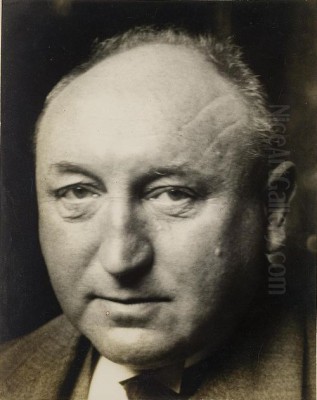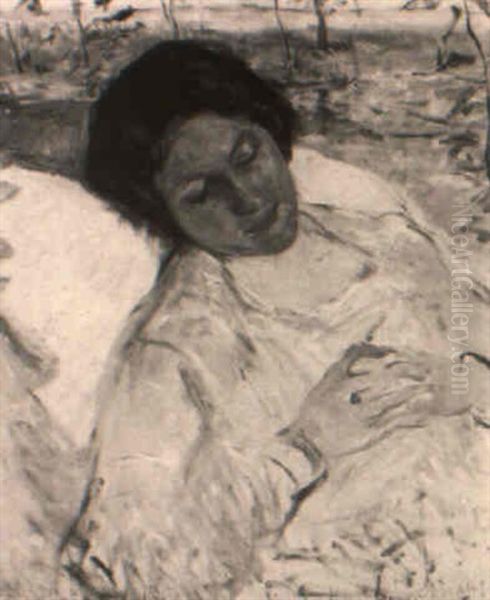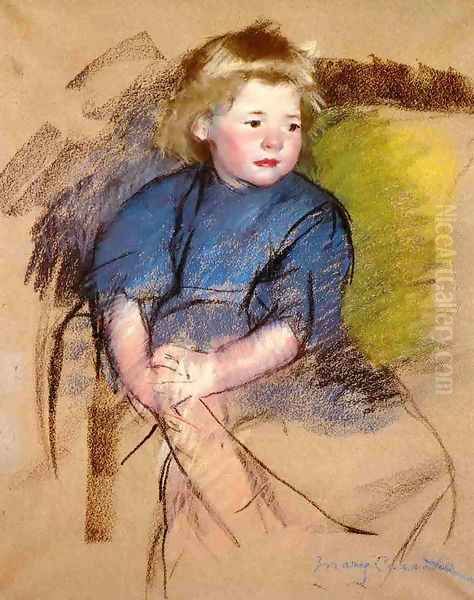
Simon Willem Maris, a name perhaps less globally recognized than some of his contemporaries, nonetheless holds a significant place in the narrative of Dutch art at the turn of the 20th century. Born in The Hague on May 21, 1873, and passing away in Amsterdam on January 22, 1935, Maris was an artist whose career bridged the lingering romanticism of the Hague School with the burgeoning vibrancy of Impressionism. His life and work offer a fascinating glimpse into a period of artistic transition, familial legacy, and the personal journey of a painter finding his voice amidst a rich artistic milieu.
Early Life and Artistic Lineage
Simon Maris was born into an artistic dynasty. His father was Willem Maris (1844-1910), one of the most prominent figures of the second generation of the Hague School, renowned for his luminous landscapes, often featuring cattle and watery meadows. Simon's uncles, Jacob Maris (1837-1899) and Matthijs Maris (1839-1917), were also celebrated painters of the Hague School, each with their distinct style – Jacob known for his atmospheric Dutch townscapes and beach scenes, and Matthijs for his more enigmatic, dreamlike figures and landscapes.
Growing up in such an environment, it was almost inevitable that Simon would gravitate towards art. He received his initial training from his father, absorbing the Hague School's emphasis on capturing the Dutch atmosphere, its muted palettes, and its realistic yet poetic depiction of local scenery and life. This foundational influence would remain a subtle undercurrent throughout his career, even as he embraced newer artistic currents. He furthered his formal education at the Royal Academy of Art in The Hague, a traditional institution that would have reinforced classical drawing and painting techniques. Later, he also studied at the Royal Academy of Fine Arts in Antwerp, broadening his exposure to different artistic approaches.
The Hague School and Its Evolution

To understand Simon Maris, one must first appreciate the Hague School. This movement, flourishing roughly between 1860 and 1900, was a reaction against the academic Romanticism that preceded it. Artists like Jozef Israëls, Hendrik Willem Mesdag, Anton Mauve, Johannes Bosboom, and Paul Gabriël sought a more direct, unembellished portrayal of Dutch reality. They were inspired by the French Barbizon School painters such as Jean-Baptiste-Camille Corot and Jean-François Millet, who advocated for painting outdoors and depicting rural life with sincerity.
The Hague School artists often favored somber, greyed tones, reflecting the often-overcast skies of the Netherlands. Their subjects included the polder landscapes, canals, windmills, fishing villages, and the daily lives of peasants and fishermen. Willem Maris, Simon's father, was particularly adept at capturing the play of light on water and the coats of animals, earning him the moniker "the painter of light." While Simon inherited this sensitivity to light, his interpretation would evolve, influenced by the brighter palette of Impressionism.
Embracing Impressionism
While the Hague School provided his artistic grounding, Simon Maris was drawn to the innovations of Impressionism, which had originated in France with artists like Claude Monet, Pierre-Auguste Renoir, and Edgar Degas. Dutch Impressionism, sometimes referred to as Amsterdam Impressionism, developed slightly later and had its own distinct characteristics, often focusing on urban life, as seen in the works of George Hendrik Breitner and Isaac Israëls (son of Jozef Israëls).
Simon Maris carved out a niche that could be described as a gentler, more lyrical form of Impressionism, often applied to subjects that resonated with both Hague School traditions and Impressionist sensibilities. He became known for his skillful rendering of light and atmosphere, but with a palette that was generally brighter and more varied than that of the older Hague School masters. His brushwork became looser and more expressive, capturing fleeting moments and sensory experiences. He was particularly adept at figure painting, portraits, and sun-drenched beach scenes, often featuring children or elegant women.
Key Themes and Representative Works
Simon Maris's oeuvre is characterized by a refined sensitivity and an appreciation for the beauty of everyday moments. His subjects often included portraits, particularly of women and children, genre scenes, still lifes, and landscapes, especially coastal views.

One of his most celebrated works is "Donkeys on the Beach, Scheveningen." This painting exemplifies his Impressionistic approach. It depicts a familiar scene at the popular Dutch seaside resort: donkeys waiting to give rides, with figures in the background. Maris masterfully captures the bright, diffused light of a summer day, the sandy texture of the beach, and the relaxed atmosphere. The colors are luminous, and the brushstrokes are visible yet controlled, conveying the scene with freshness and immediacy. This work is often cited as a prime example of Dutch Impressionism, showcasing a lighter touch and a focus on leisure that distinguished it from the more somber themes of the earlier Hague School.
Another significant piece is "Young Woman with a Fan" (circa 1906). This elegant portrait showcases Maris's skill in capturing character and mood. The subject, a young woman dressed in fashionable attire, holds a fan, a common accessory of the period. The painting is notable for its delicate color harmonies, the subtle play of light on fabric and skin, and the quiet introspection of the sitter. It reflects an international sensibility, akin to portraits by contemporary artists like James McNeill Whistler or John Singer Sargent, yet retains a distinctly Dutch intimacy.
His painting "Mère et enfant" (Mother and Child), dated 1917, is a tender portrayal of maternal affection. Rendered with soft colors and a gentle application of paint, it highlights his ability to convey emotion through subtle means. The natural light filtering into the scene and the intimate grouping of the figures are characteristic of his approach to domestic subjects, imbuing them with warmth and serenity.
Other subjects that frequently appeared in his work included children playing, women in interiors engaged in quiet activities, and sunlit garden scenes. These themes allowed him to explore the effects of light and color in varied settings, always with a sense of grace and charm.
Travels and Artistic Exploration
Like many artists of his time, Simon Maris sought inspiration beyond his native borders. In 1899, he embarked on a significant four-month journey through Europe with Casparus van Houten, a sugar merchant and art enthusiast. Their itinerary was extensive, taking them from Paris through Nice, Genoa, Florence, Rome, Venice, and Naples. During this trip, Maris kept a detailed travel diary and took numerous photographs, documenting his experiences and observations.
This journey would have exposed him to a vast range of art, from the classical masterpieces of Italy to the contemporary art scenes in Paris. Seeing the works of the French Impressionists firsthand, as well as the rich artistic heritage of Italy, undoubtedly broadened his artistic horizons and may have reinforced his own leanings towards a brighter palette and a more modern sensibility. His travel diaries, later discovered by his grandson Thijs Maris and published by Peter van der Goolen, provide valuable insights into his artistic development and his keen eye for detail.
Relationships with Contemporaries
Simon Maris was an active participant in the Dutch art world and maintained relationships with many of his contemporaries. His family connections naturally placed him at the heart of the Hague School circle. Beyond his father and uncles, he would have known other figures associated with the movement or its later iterations.
A particularly notable friendship was with Piet Mondrian (1872-1944). In their earlier years, before Mondrian embarked on his path towards abstract art, he and Maris shared a period of artistic camaraderie. They traveled together to Spain in 1903-1904, an experience that Mondrian documented in his sketchbooks. During this period, Mondrian was still working in a more naturalistic, albeit increasingly stylized, manner. Maris, known for his sociable nature and perhaps a more pragmatic approach to the art market, reportedly acted as an art dealer or intermediary for Mondrian on occasion, helping him sell some of his earlier, more commercially viable works. This support would have been valuable to Mondrian as he navigated his artistic evolution.
Maris was also friends with artists like Julius van de Sande Bakhuyzen (1835-1925), a landscape painter associated with the Hague School, and Henricus (Henk) van Borssum Buisman (1873-1951), a contemporary known for his portraits and genre scenes. These connections underscore his integration within the artistic community of his time. He was also associated with various art societies, such as Arti et Amicitiae in Amsterdam and Pulchri Studio in The Hague, which were important venues for exhibitions and artistic exchange.
The broader artistic context in the Netherlands at this time was rich and varied. While Maris pursued his Impressionistic path, other movements were also gaining traction. Symbolism and Art Nouveau found expression in the works of artists like Jan Toorop (1858-1928) and Johan Thorn Prikker (1868-1932). The legacy of Vincent van Gogh (1853-1890), though he spent much of his productive career outside the Netherlands, was beginning to be recognized and would profoundly influence later generations. Maris's art, therefore, developed within a dynamic environment of diverse artistic explorations.
Maris's Style in Context
Simon Maris's artistic style can be seen as a harmonious blend of influences. He retained the Hague School's deep appreciation for the Dutch landscape and its atmospheric qualities but infused it with the lighter palette, broken brushwork, and focus on capturing fleeting moments characteristic of Impressionism. Unlike some of the Amsterdam Impressionists like Breitner, whose work often depicted the raw, bustling energy of city life, Maris's paintings generally exude a sense of tranquility, elegance, and refined observation.
His figure paintings and portraits are particularly noteworthy for their psychological insight and graceful execution. He had a talent for capturing the personality of his sitters, often women and children from affluent backgrounds, portraying them with a sensitivity that avoided sentimentality. His beach scenes and garden views are filled with light and air, celebrating the pleasures of outdoor life.
It has been suggested by some art historians that Maris's sociable nature and enjoyment of life, while contributing to a charming personality, might have perhaps tempered the intensity of his artistic ambition or prevented him from pushing artistic boundaries as radically as some of his contemporaries, like Mondrian. However, his consistent output of high-quality work, characterized by its technical skill and aesthetic appeal, secured him a respected position in Dutch art.
Later Years and Legacy
Simon Maris continued to paint and exhibit throughout his life, primarily based in Amsterdam. He remained a popular portraitist and his Impressionistic scenes found favor with collectors. His work was regularly included in exhibitions in the Netherlands and occasionally abroad.
His legacy is that of an accomplished painter who skillfully navigated the transition from the 19th-century realism of the Hague School to the more modern sensibilities of the early 20th century. He successfully adapted Impressionist techniques to Dutch subjects, creating a body of work that is both aesthetically pleasing and historically significant. His paintings offer a window into the genteel life of his era, captured with a delicate touch and a keen eye for light and color.
The rediscovery and publication of his travel diaries have added another dimension to our understanding of the artist, revealing his thoughtful engagement with the art and culture he encountered on his travels. His works are held in various public and private collections, including the Rijksmuseum in Amsterdam, the Kunstmuseum Den Haag, and the Dordrechts Museum.
Conclusion: An Enduring Charm
Simon Maris may not have been a revolutionary figure in the mold of Van Gogh or Mondrian, but his contribution to Dutch art is undeniable. As the son of the illustrious Willem Maris and a nephew to Jacob and Matthijs Maris, he carried forward a significant artistic heritage. He did so not by mere imitation, but by forging his own path, embracing the light and color of Impressionism while retaining a deep connection to Dutch artistic traditions.
His paintings, whether depicting lively beach scenes, intimate domestic interiors, or elegant portraits, are characterized by their technical proficiency, refined sensibility, and an enduring charm. They reflect a world of quiet beauty and gentle pleasures, rendered with a skill that continues to appeal to art lovers today. Simon Maris stands as an important representative of Dutch Impressionism, an artist who successfully synthesized tradition and innovation, leaving behind a legacy of luminous and engaging works that enrich our understanding of Dutch art at the turn of the 20th century. His ability to capture the subtle nuances of light and atmosphere, combined with his empathetic portrayal of human subjects, ensures his lasting place in the annals of art history.